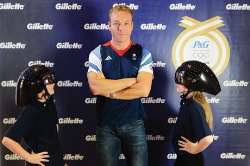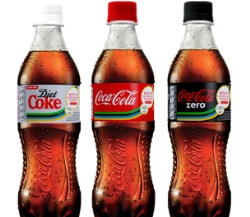Going the distance?
Legacy stands sporting chance if sponsors flex their financial muscle
The enthusiasm for sport generated by London 2012 provides a platform from which to improve public health. But should Olympic sponsors be doing more to create a lasting legacy? asks Michael Barnett.

When the Olympic flame was extinguished at the end of the Paralympic Games and athletes took their medals back home to all four corners of the world, attention turned to delivering on the promise to “inspire a generation” and taking a once-in-a-lifetime opportunity to create a lasting legacy.
But now the Olympic Stadium lies empty and parts of the Olympic Park are being dismantled, how serious are brands about salvaging a legacy of better public health?
Sponsor McDonald’s has admitted to Marketing Week that it is working towards “no specific targets” for improving health through future Olympic marketing initiatives, while Cadbury says its plans are “still a work in progress”. Coca-Cola points to an existing long-term partnership with children’s sport charity StreetGames as its main contribution to a legacy of health and fitness, while Adidas says the 50 adiZone outdoor gyms that have already been built since 2008 are its legacy.
McDonald’s vice-president of UK marketing Alistair Macrow points to the fact that the fast food chain ran several promotions before the Games and has an ongoing project called KickStart to fund football clubs and constantly reviews its menu options for nutritional value (see Case Study, below).
“In the run-up to London 2012, our ‘Mascotathon’ Happy Meal promotion saw us give out millions of activity toys that encouraged children to get active through play. We followed this with a second Olympic Happy Meal promotion, available during Games time, which gave children access to high-quality grassroots sports in their local area. Each Happy Meal box featured a free sport session voucher for children to get out and try one of seven Olympic sports.”

Procter&Gamble is using Sir Chris Hoy to inspire future athletes
Other sponsors mention even fewer specific legacy plans that could take immediate advantage of this summer’s high levels of interest around the Olympics and Paralympics. On behalf of official treat provider Cadbury, Tony Bilsborough, head of corporate affairs at parent company Kraft Foods, says: “Cadbury never linked its sponsorship of London 2012 to either sports participation encouragement or diet and lifestyle. From the very beginning, our sponsorship was solely tied to encouraging communities up and down the land to have fun.”
In a separate response, Kraft Foods head of UK communications Josephine Bradley says its legacy objectives are still being worked on “although we are hoping to continue our association with the British Paralympic Association”. Answering Marketing Week’s enquiries during the Paralympics, she adds: “We are going to take stock when everything’s over and plan next steps from there.”
But the opportunity for sponsors’ marketing to capitalise on current enthusiasm will not last forever. Marc Woods, who has won 12 Paralympic swimming medals including four golds and who commentated on London 2012 for BBC Radio 5 Live, argues that it is crucial to “strike while the iron is hot” while people still feel the afterglow of sporting success. He says: “The sponsors definitely have a responsibility to not simply let this fade away.”
Woods says that the UK needs to maintain the momentum of positivity that the public currently feels about sport. If brands and the media don’t show a commitment towards sustaining the sudden interest in disability sport thanks to the Paralympics, then it will be forgotten quickly, he adds (see Viewpoint, below).
“It would be lovely to see brands picking up the Paralympic athletes post-Games in the same way they used them pre-Games,” he says.
New research into young people’s attitudes to health and fitness, seen exclusively by Marketing Week, suggests that doing so would indeed resonate with consumers. Athletes, rather than footballers for example, are currently the sportspeople that 11- to 18-year-olds admire most, according to the study by ResearchBods, which surveyed 1,000 children before and after the Olympics.
The proportion favouring athletes jumped from 16 per cent in June to 26 per cent in August. Over the same period, footballers fell drastically in their estimations, mentioned by only 7 per cent after the Olympics, compared with 15 per cent before.
Yet that is not all that changed in between the two surveys. Since the Olympic Games closing ceremony on 12 August, young people have also been inspired by the Games to get more involved in athletic activities.
Paralympic sponsor Sainsbury’s aims to get 20 million more children into sport by 2020 and since 2005 has also given out £115m in funding for equipment and activities to make young people more active
Before the event, 32 per cent said they intended to get generally fitter as a result of the Olympic influence, but this has since risen to more than 56 per cent. And 30 per cent now say they are determined to train harder at a sport they already play, compared with 21 per cent who said the same before the Games began.
Girls have been influenced more strongly than boys, according to the data, but fewer girls say they were already playing sport before the Games. Those at the younger end of the 11-18 age range were more likely already to be participating.
ResearchBods director Robin Hilton says: “For a lot of campaigns that target young people and try to get them involved in things, awareness levels are quite good. You can make people aware of things, but to get young people to actually change their behaviour is really difficult. This research seems to imply that young people who aren’t involved in sport want to get fitter. That is usually really hard to achieve.”
Some of the sponsors do have specific marketing plans in place for turning this signal of intent into actual sporting participation. Paralympic sponsor Sainsbury’s aims to get 20 million more children into sport by 2020 and since 2005 has also given out £115m in funding for equipment and activities to make young people more active. Last week, it also announced further plans for ensuring that the legacy of the Paralympics is embedded in the UK for years to come (see Case Study, below).
Consumer goods manufacturer Procter & Gamble – like McDonald’s and Coca-Cola, a worldwide sponsor of the IOC – has also committed to spending $25m (£15.7m) worldwide over the course of its Olympic partnership, which runs until 2020, on creating a sporting legacy from the Games. James Williams, of P&G corporate communications, says this money is being channelled into a variety of projects around the world (see Case Study, below).
He adds: “The main legacy plan that we have globally is an investment in youth sport. It is derived from the ‘Proud sponsor of mums’ campaign and everything we did around the Olympics.
“The company asked mothers: ‘if we were going to help them with our legacy programme, what would that look like?’ They told us youth sport is the biggest thing that we could do to help. They said that what gets their kids off to a good start in life is access to sport – sports training, facilities and equipment.”

London 2012’s official bank, Lloyds Banking Group, has committed to running its National School Sports Week with the Youth Sport Trust again in 2013, seeking to add to the 9 million children it says have taken part since 2009. In 2012, schools were encouraged to stage their own version of the Games. The latest announcement was made during the Olympics, endorsed by six-time cycling gold medal winner Sir Chris Hoy.
Hoy pointed out at the launch: “I had the opportunity to play a wide variety of sports at school, as did a lot of our Team GB and Paralympics GB heroes, and I know that in order to motivate more children it’s about providing opportunities and fun experiences to keep them engaged.”
Just as ResearchBods’ survey has found the Olympics have generated enthusiasm for sport, Lloyds own research indicates that when sponsors provide these kinds of opportunities for young people to participate they take immediate inspiration. Lloyds found in 2012 that 64 per cent wanted to play more sport after the week was over.
Other elements of Lloyds’ legacy were still in their planning stage when Marketing Week interviewed its head of sponsorship Gordon Lott in July, ahead of the Olympics, but he suggested that social media could become a new forum for the company to give legacy activities greater attention. The main focus centres on community projects, of which sports investment is only a part of the £85m that the bank spent last year. He said: “I can see a situation where those become much more prominent on our Facebook page.”
Taking an entirely different view of the Olympic sponsors’ legacy responsibilities, Innocent’s approach is to assert the innate health benefits of its products. Though the juice and smoothie maker is majority-owned by Coca-Cola and gains its Olympic association through that corporate relationship, the two brands have separate operations and marketing strategies.
Other sponsors mention even fewer specific legacy plans that could take immediate advantage of this summer’s high levels of interest around the Olympics and Paralympics
But the initiatives that Innocent already runs relating to children’s health are unlikely to be given an Olympic slant in the future, according to marketing director Douglas Lamont, because the products that featured in its sponsorship activities and which were sold in the Olympic Park during the Games weren’t those targeted at children.
Lamont goes even further, claiming that Innocent’s most effective contribution to an Olympic legacy of improved health would be simply to sell more products: “From a kids’ nutrition perspective, the best job we can do is get our products to the most kids possible. The Government is supportive as well, because we deliver a healthy drink to kids, which is why we can sell into schools and advertise on kids’ TV. It’s about finding ways to encourage kids to drink more smoothies and drinks from us.”
He also explains that the most important marketing job Innocent has to do to in order to improve diets is to ensure that it provides products that are healthy, appeal to children and are affordable for their parents. Beyond that, Lamont suggests that its efforts would involve more of the kinds of projects it was already involved in.
“What we’ve got to do is a bit of education – part of our previous campaigns has been education for mums. On kids’ TV it’s more about encouraging a sense of fun, but on mainstream TV it’s about explaining that this is a good way to get fruit into kids.
“We’ve also done various booklets on healthy eating and pushed those out through Mumsnet – tips for healthy lunchboxes and how to help your kids. It’s not just about putting a smoothie in it, but about what other foods to have in their lunchboxes. Partnerships like that are part of the programme of work that we have.”
But few of the other Olympic sponsors are in Innocent’s enviable position of being able to argue that their products could themselves leave a legacy of better health. And even for Innocent, education alone might not make the critical difference in turning Olympic inspiration into healthy eating.
According to ResearchBods, the majority of children in its survey already have at least some understanding of what a good diet involves. Asked to score how much they know about healthy eating on a scale of 1 to 5, where 1 is nothing at all, only 3 per cent score themselves below 3. But for the majority of young people, this knowledge alone does not appear to be enough to spur them to action, since 64 per cent say they know what is required for a healthy diet but do not always choose to eat that way.
Against that less-than-promising statistic stands the finding that 94 per cent of those surveyed watched at least some Olympics coverage. The UK might never again have a platform with the same level of reach from which to launch an effective campaign to improve public health.
The Games have undoubtedly had the desired effect of inspiring a generation, but the sponsors still have a job to do to ensure the legacy lasts.
Sainsbury’s
Sainsbury’s is unique among the ‘Olympic family’ of brands in that its sponsorship of London 2012 was solely of the Paralympics. That not only gave the supermarket a degree of focus in its marketing around the Games, but also in its legacy planning.
Last week, Sainsbury’s announced that it will spend £1m over the next four years on a scheme aimed at ensuring physical education in schools is inclusive and accessible, particularly for children with a disability or special educational needs. Active Kids for All, which is an extension of the Active Kids programme that has been running since 2005, will provide training programmes for PE teachers in partnership with the English Federation of Disabled Sport, the Youth Sport Trust and the British Paralympic Association (BPA).
The aim is to help 500,000 children with disabilities lead more active lives by giving their teachers more confidence to include them. About 80 per cent of these children are estimated to attend mainstream schools. The new announcement extends its investment in youth activities that has seen Sainsbury’s provide schools with £115m-worth of equipment over the past seven years.
Sainsbury’s has also promised to continue supporting the BPA until the 2016 Games in Rio de Janeiro.
According to BPA chief executive Tim Hollingsworth, legacy is the wrong way to think about the relationship, rather it should be considered a means of maintaining the momentum behind disability sport created by the London Paralympics towards the next event, which will be the Winter Paralympics in Russia in 2014.
British Paralympic Association's Tim Hollingsworth
Sainsbury’s chief executive Justin King tells Marketing Week: “It’s much more than legacy, it’s about recognising that something in society has changed. It’s not just about the main event, but about what happens if we kick this moving ball and propel it on to bigger and better things.”
Procter & Gamble
One Olympic sponsor that is able to cite the specifics of its legacy plan is Procter & Gamble. Characteristically for the FMCG giant, where marketers are key business decision-makers, P&G’s legacy aims are firmly grounded in its sponsorship campaign strategy, which focuses on the role of mothers in supporting athletes.
According to James Williams, of P&G corporate communications, the company’s pledge to raise $25 million (£15.7 million) for youth sport worldwide by 2020 was originally devised as a result of asking mums of Olympians and ordinary people how best it could contribute to a sustainable Olympic legacy. That figure was initially $5m (£3.1m), which was announced in January at the World Youth Games, but after exceeding this target by $1m (£620,000) by the time of the Olympics, P&G announced the extension in August.
The level of investment and the stage of progression in disbursing those funds differs around the world. The company is still working with national Olympic committees in Western Europe to decide where they should be allocated. Future UK legacy projects are therefore yet to be decided.
But this year, through its Gillette men’s grooming brand, P&G has invested in developing youth sport coaching as a means of contributing to athlete development. It also sponsors an award given by global non-governmental organisation Beyond Sport, presented this year to UK charity Street League, which helps disadvantaged people into education, training or employment through football-based workshops.
Elsewhere in the world, P&G’s money is being used in projects to provide sporting equipment and renovate sports facilities in Latin America, Africa and the Middle East; in Eastern Europe, it is funding youth sport camps; and in the US it is being used as part of the Team USA Youth Sports Fund, which provides grants to governing bodies for youth sport.
On the subject of what P&G’s overall objectives are, Williams says: “I don’t think we have set a specific soundbite goal yet on what we hope to achieve. The pledge is the investment, and we are working now on how it is best used by country.”
Yet he is able to make reference to the impacts of projects already underway. In Mexico, the Sport for a Better Future initiative is supporting 200,000 children, he claims; in India, new playgrounds have been built, catering for 85,000 children in 40 schools; and in Russia a sport camp has so far hosted 4,000 children.
McDonald’s, Coca-Cola and the IOC’s “question marks”
It hasn’t been hard to find people critical of the fact that fast food chain McDonald’s and soft drink maker Coca-Cola, two brands that sell sugary or high fat products, are perennial partners of the world’s biggest sporting event.
Yet it still surprised commentators when International Olympic Committee president Jacques Rogge confessed to the Financial Times that there had been “question marks” over renewing their worldwide Olympic sponsorship until 2020. They were question marks that both brands evidently answered to the IOC’s satisfaction.
“We’ve said to them: ‘Listen, there is an issue in terms of the growing trend on obesity, what are you going to do about that?’,” Rogge was quoted as saying. Though he said it “was not an easy decision”, he added that “we decided to go and to have the benefit of their support at grassroots levels”.
McDonald’s vice-president of UK marketing Alistair Macrow points to one such example of its grassroots activity, although this is run as part of its partnership with the four UK national football associations, rather than with the Olympics.
“In May last year we launched a new online hub called KickStart, which provides lots of information about the McDonald’s football programme and gives people the chance to apply for a small grant for their football club or league,” he says.

Coca-Cola is focusing its activities on the next generation
Coca-Cola also says its legacy will principally consist of an existing grassroots partnership with children’s sport charity StreetGames, which has been in place since 2010. With Coca-Cola funding, StreetGames has offered £5,000 bursaries to developing athletes, while 45 young people aged 18-21 were given paid roles at Olympic venues during the Games through the partnership.
Coca-Cola public affairs director Joel Morris says: “We connected StreetGames with our London 2012 sponsorship to raise awareness of the charity and help increase participation in the sports programmes it provides for young people in some of the most deprived communities in the UK. The aim of our work with StreetGames is to deliver sport to 110,000 young people who otherwise may struggle to get involved in sport. The programme has also contributed to Locog’s legacy targets.”
Smoothie brand Innocent, which is majority-owned by Coca-Cola, was able to style itself the official smoothie and juice partner of the Olympics thanks to Coca-Cola’s IOC sponsorship. According to Innocent marketing director Douglas Lamont, the two brands have a “light-touch” relationship and given that Innocent makes primarily fruit-based products, it can make healthy eating an explicit element of its marketing.
“We go down a route of educating people around healthy eating – initiatives like lesson plans to teach kids to eat healthily – more than active sport.”
However, Lamont adds: “These are not Olympic-themed specifically. We didn’t have the kids products on the park so what we could do around those was more limited.”
Viewpoint
Marc Woods
Former Paralympic swimming champion and BBC Radio 5 Live commentator
We need to strike while the iron is hot. The sponsors definitely have a responsibility not simply to let this fade away. It would be lovely to see brands picking up the Paralympic athletes post-Games in the same way they used them pre-Games. I think the Government clearly has a responsibility not to slash funding on sport, not to dismantle school sport. But that process has started.
We need to make sure we keep some momentum going. Schools over the past couple of years have been very good at grasping the opportunity. We want the little ones to have fun, we want the slightly older ones to be active and we want the even older ones to start thinking about goals.
The media also has a responsibility not to wait another four years before covering Paralympic sports. Let’s make sure we cover the world championship swimming, for example. The media is quick to say there’s an appetite for Paralympic sport, but in the past this hasn’t been the case. The appetite has been created, but people will forget, so it needs to be maintained and the momentum driven forward.
From a Paralympic point of view, people are now more open-minded about disability and about what people can achieve, rather than focusing on what they can’t do. Disability is relative to the task. If there is one piece of the legacy that the Paralympics can deliver on – and that we’ll need to keep reminding people of and driving home – it is that you don’t judge people on the one thing they can’t do.









